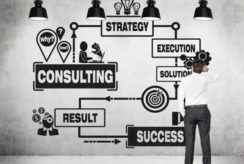At Wavestone, we know how important it is to invest time in keeping up to date with the latest developments in our industry and regularly attend events, seminars and conferences.
Many of our clients are exploring ways to implement Internet of Things (IoT) into their business, as part of their IT Transformation strategy, and define what the real business benefits are of doing so. It’s interesting to see how this is being put into action across different industries, which is exactly what this event showcased
The Event
IoT is revolutionising the way we lead our lives and the way businesses operate today. This event explored the ways in which IoT is building bridges between digital brands and physical space.
The Definitions
The Digital Technology: Internet of Things (IoT)
Connecting “everything” in the world together through the internet. “Everything” is defined as devices with unique identifiers (UIDs), which can transfer data over a network without human interaction.
The Physical Space: Edge Computing
Resources such as servers, storage, software and network connections deployed at the edge of a network. This enables “on the spot” computing and analytics without having to transport information to a corporate data centre. Being closer to the edge of the network helps to analyse data in real-time.
The Roundup
The presenters covered three areas within IoT; Supply Chain, Insurance and Environment, explaining a host of examples, looking closely at how these are being used to drive real benefits.
Supply Chain
- Asset tracking: RFID and GPS sensors can track products “from floor to store” and beyond. At any point in time, sensors can gain granular data including the temperature an item is stored, how long it spent in cargo and even how long it took to fly off the shelf.
- Connected fleets: The use of data derived from fleets can help to create a lean supply chain, avoid bottlenecks and deliver goods quicker.
- Inventory, forecasting and warehouse management: WiFi robots can scan QR codes on its products to track and triage orders. Data can be used to improve efficiencies on manufacturing schedules.
| Watch Out: Companies can improve quality control, on-time deliveries and product forecasting and ultimately become more profitable. However, an increased reliance on IoT will increase cyber security risk and businesses must prepare for this. |
Insurance
The “Analyse and Act” operating model:
- Connected Biometrics: The use of wearables enables Insurance companies to track daily activity, calorie burn, heart rate and sleep pattern history and award points to customers who have healthy lifestyles. This improves the understanding of risk to more accurately price and reduce claims cost.
- Diagnostics: Intelligent sensors embedded in toys, consumer electronics, industrial machines and vehicles allow for an extended warranty protection, predictive and preventative service prior to product breakdown and component failure.
- Geospatial Applications: Telematics can gather history of speed, distance, steering and break patterns to generate an appropriate premium.
| Watch out: If insurance companies can anticipate every risk will there be a conflict of interest? Consumers want to take advantage of the value, but often don’t want to give away private information, which leaves a conflict of interest. |
Environment
- Environmental Sensors: Measuring air or water quality, radiation and detecting hazardous chemicals can help track the evolution of the environment. People who operate in hazardous conditions can benefit from this real time environmental data.
- Smart Farming: Controlling crop, fertilisers, soil condition or greenhouse irrigation through sensors.
- Energy Efficiency: IoT climate mitigation strategies could reduce global climate change by 16.5% by 2020 through Smart Home, Smart Building energy management, plus allow for efficient use of home appliances and smart grid devices.
| Watch out: Connecting millions of devices requires of lot of energy. LPWAN (Low Power Wide Area Network) work underground or can be deployed at a long distance from the nearest antenna. Battery life is extended to last for years, thus reducing the energy impact. However, where will the primary resources come from to tackle the demand and will batteries and other resources be recyclable? |
Key Takeaway
IoT impacts a wide variety of different industries and continues to extend its reach. It requires a variety of skills to use these advancements in the right way. New physical and intellectual resources are needed, and the costs associated are not neglectable. However, if used efficiently, “connecting things” together can decrease costs, increase efficiency, improve the customer experience and save time.
Wavestone will be launching an IoT UK Start Up Radar later this year, providing insight into the market, the leading companies and innovative initiatives. Keep a look out!



